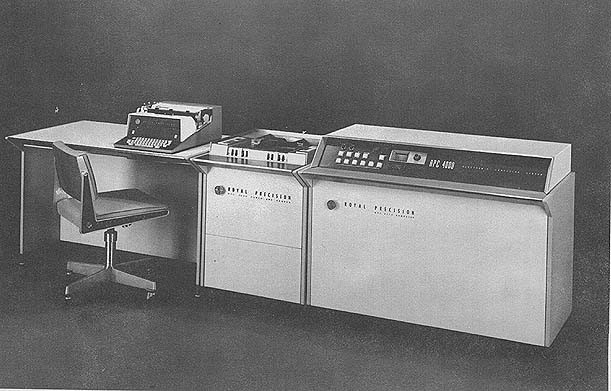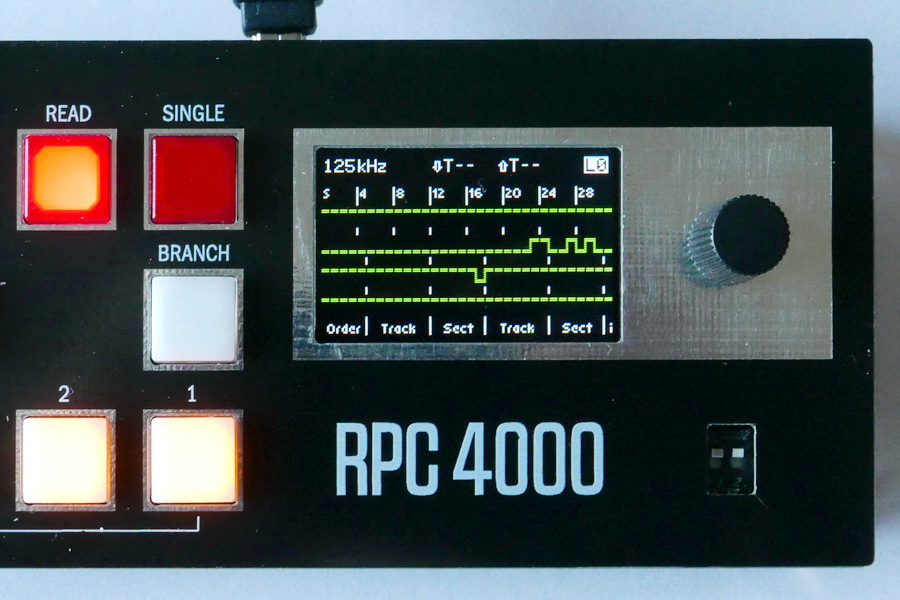© 1999-2023 Jürgen Müller
juergen@e-basteln.de
Imagine working at Royal Precision in 1960. This joint venture of General Precision and Royal McBee is a great place to work: With the LGP-30, they are the market leader in the small computer segment – 450 units sold! Only IBM has a better seller, the IBM 650: A larger system, with close to 2000 units in the market.
The LGP-30 is a magnetic drum computer. It is awkward to program, because the programmer has to work around the constraint of the sequential access to data and instructions on the drum. But it is compact and affordable, using only about 100 tubes. Only 24 of these are needed for the actual CPU logic!
Where to go next? Upmarket, to eat IBM’s lunch! In 1960, Royal Precision proudly announces the RPC-4000: Fully transistorized, which enabled more complex CPU logic; more flexible, scalable peripherals, and – a slow, non-random-access magnetic drum! Which is why so few of us today have heard of Royal Precision…
This page gives some information about the original RPC-4000, and briefly describes my FPGA-based replica – which is still a work in progress at this time.

The RPC-4000, causing some excitement (at least in this ad from 1960...)
The RPC-4000 was structurally quite similar to its predecessor, the LPG-30: While it used transistors instead of vacuum tubes, it was still a bit-serial computer built around a magnetic drum, which served as the main memory. Compared to the LGP-30, the drum capacity was increased, but the speed (bit rate, and hence computer clock speed) was not. Royal Precision implemented several tricks to enable faster program execution.
In contrast to the LGP-30, the RPC-4000 was not a big success in the market. The 1964 BRL market report claims 104 units in operation, and that probably includes customized special-purpose devices. Disappointing compared to the approx. 500 LGP-30 units which had been produced by that time!
The competitors had released new computers with the brand-new ferrite core memory at the same time as the RPC-4000. No longer hampered by the speed of a mechanically moving drum, and with random access to any memory cell at any time, they left the RPC-4000 behind, technologically and commercially. IBM announced the 1401 in late 1959, and according to an earlier BRL report, had installed 2800 units by 1961, at a similar $70,000 price point. DEC’s PDP-1, launched in 1960, only sold 53 units in total, but laid the foundation for many generations of highly successful small computers.
I am aware of only one surviving RPC-4000, and that one is apparently in non-working condition. It is owned by the Computer History Museum in Mountain View, California, but I understand it is in storage, not on display in the collection. The CHM has a brief description here, although with a clearly incorrect date.

The RPC-4000 (right) with a modernized Flexowriter terminal and the standard paper tape punch/reader accessory (center)
So, why would one be interested in the RPC-4000? A few reasons for me:
It is one of the last general-purpose computers designed around a magnetic drum memory. I find it fascinating to see how the developers tried to squeeze the last bit of performance out of this proven design by various tricks (dual address scheme and optimizing assembler to optimize the placement of instructions around the drum, fast data tracks, auto-repeat instruction) – only to be left way behind when core memory arrived at the scene. A look at “disruptive innovation” from the losers' side; or maybe just morbid fascination? ;-)
The RPC-4000 reached some fame among a contemporary non-technical audience since it could compose poetry! The “Auto-Beatnik” program, developed by a research team at Librascope, was featured in Horizon and LIFE magazine. Read some sample poems, a brief report by its creator, R.M. Worthy, in the internal Librazette journal (page 2, discussing the precursor version running on the LGP-30), and its mention in the March 3, 1961 issue of LIFE magazine (pages 118-119).
And finally: The RPC-4000 is the computer starring in the Story of Mel! A famous piece of computer folklore, celebrating the “real programmers” from the early days, preserved in the internet jargon file. I have not given up hope of finding and running Mel’s original Blackjack program eventually!
I found this interesting enough to design a replica based on the same approach as my LittleGP-30: An FPGA to implement the CPU logic and magnetic drum, with a front panel to turn this into a self-contained, handheld gadget. An external computer, connected via USB, replicates the terminal and paper tape units.

The replica is based on a Spartan-6 FPGA board, mounted behind a small, handheld front panel.

A color LCD replaces the oscilloscope display for the CPU registers. The rotary selector to the right of the display is actually present in the real RPC-4000, to select one out of eight accumulators for display. As are the two switches below the front panel, which can write-protect critical drum tracks.
This project is still work in progress, and hence I do not have building instructions or project files online yet. The current status, as of November 2018:
The PCB design for the front panel and overlay boards is complete. I had a pilot batch of boards produced, populated two of them, and the hardware seems to work nicely.
The CPU and enhanced memory drum, with its various fast-track tricks, have been fully implemented in the FPGA. Superficial testing only, but I have double- and triple-checked the logic equations, and fixed several typos (some my own, some in the service manual). So I hope the CPU is essentially working now.
The user interface (front panel buttons, LCD screen, HDMI drum display) is complete and seems to work well. The enhanced peripheral engine, with separately addressable devices connected via a two-channel USB port and serial port, is also up and running. I can load individual instructions into the CPU, start them, observe register changes and typewriter output.
Storing and retrieving drum contents via the serial interface (XModem) or the on-board EEPROM finally works as well, just in time for showing the replica at the Vintage Computer Festival in Zürich!
The major gap deserves its own section, right below: No software yet…
A decent selection of scanned manuals for the RPC-4000 is available e.g. in the Bitsavers archive. The archive also comprises a set of “program writeups” which document a few library routines and application programs – including Mel Kaye’s Blackjack program. But none of the actual software is available online.
So I embarked on this project with two leads to RPC-4000 software, but knowing full well that I might end up with a computer replica without any software to run on. And indeed that risk has caught up with me…
Paul Pierce has a large library of paper tapes from Control Data, which is believed to contain the RPC-4000 system software. But the tapes are in bad condition, and Paul wants to hold on to them until he – or someone at the Computer History Museum in Mountain View, where they are eventually meant to go – finds the time to catalog and scan them.
The astronomical observatory at Munich University used to operate an RPC-4000, with a rare magnetic tape accessory developed by the German distributor, Eurocomp (Schoppe & Faeser). A few tapes have survived, and with the help of several friendly souls I managed to digitize and decode a “System” tape. A nice little project in itself, which I hope to eventually document here.
Sadly, the tape does not contain the binary dumps of the magnetic drum which I was hoping for. Either it’s some other data entirely, or the drum contents are further encoded in some undocumented way. Each data set on the tape is approximately four time the size of the drum capacity, which seems excessive for checksums or such…
So, here I am – plenty of manuals, a largely working replica, but no software yet. If you have any leads to paper tapes or other forms of software for the RPC-4000, please drop me a line!
I don’t have building instructions for the RPC-4000 yet, and the FPGA code will undergo some further tweaking. In the meantime, here are some very preliminary documentation and the current FPGA binary:
The bill of materials and schematics, plus some very rough notes on building and using the replica.
The current FPGA binary.
I showed the RPC-4000 replica at the Zurich Vintage Computer Festival in November 2018. The slides from my presentation are available here. The content overlaps with this page, but there is some extra detail about magnetic drum computers in general, the Story of Mel, and reading the magnetic tape from Munich.